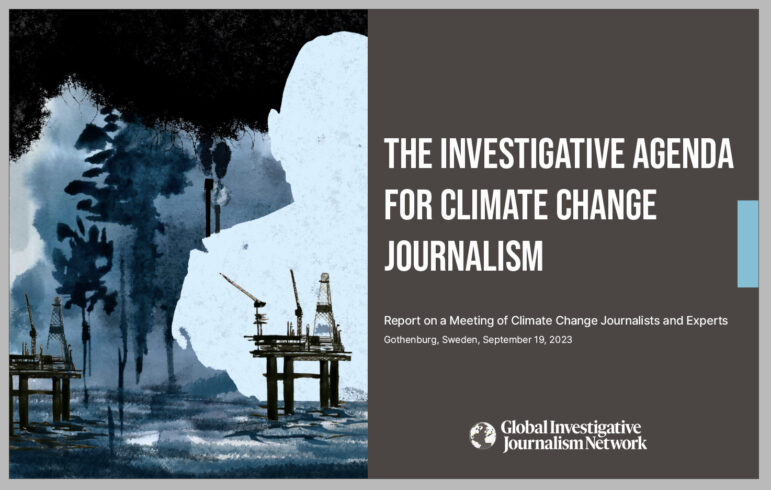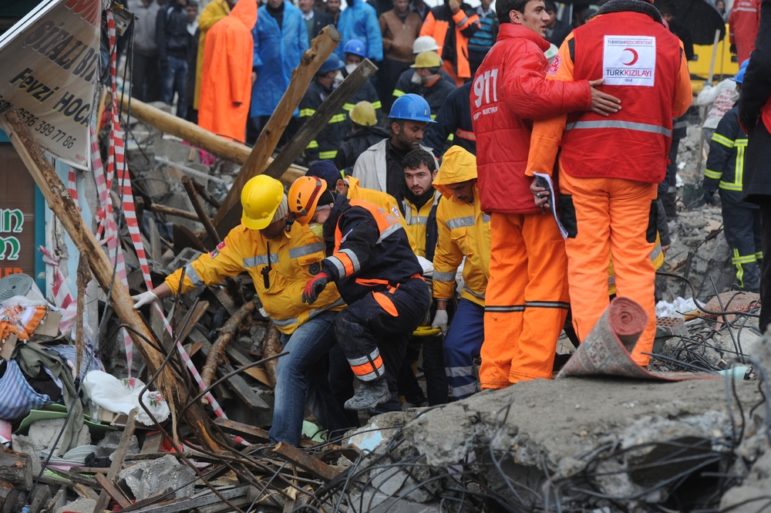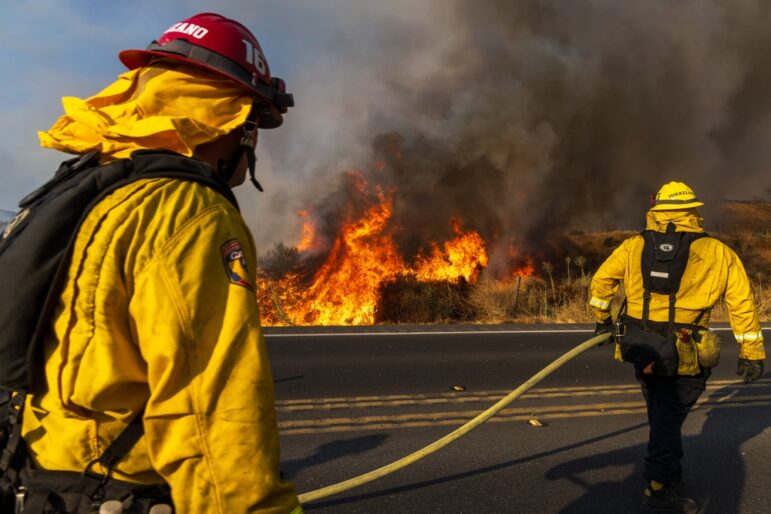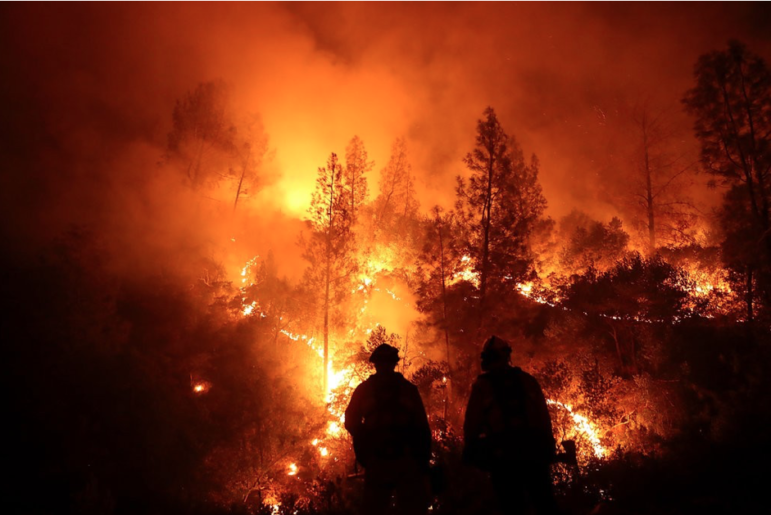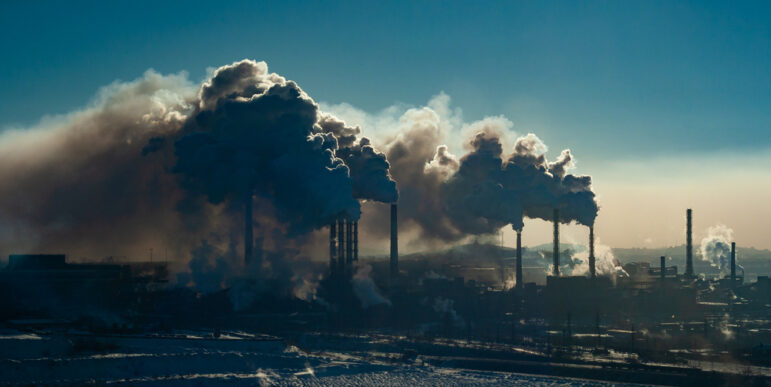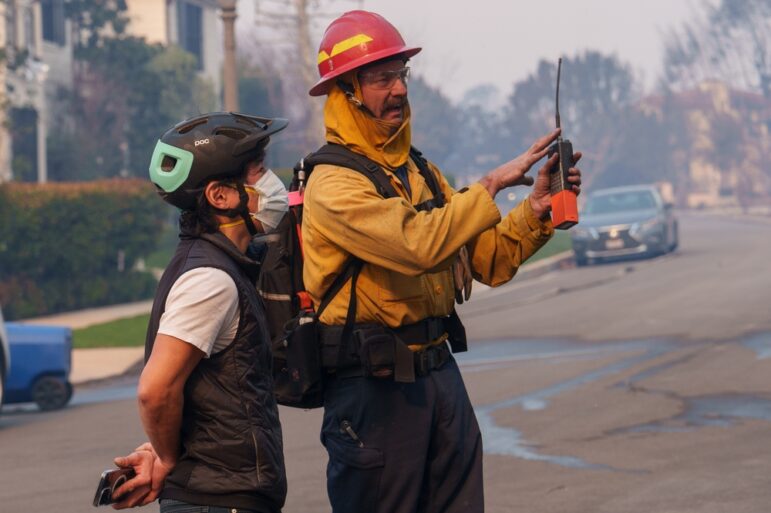

Firefighter discussing the situation on the front lines of the 2025 Pacific Palisades fire near Los Angeles. Image: Shutterstock
Wildfire Reporting — Expert Advice on Emerging Issues, Recurring Risks
The deadly fires that torched Los Angeles in January stopped burning long ago. But reporting on their aftermath continues, even as journalists prepare for the next blazes.
Journalists from around the Western US gathered online earlier this year for a Society of Environmental Journalists’ webinar on wildfire and the new extremes, where they swapped insights about field reporting and discussed how coverage is changing.
The informal debrief brought together experienced wildfire reporters, a newsroom leader who advocates for disaster preparedness, and a researcher, offering support and advice for staff journalists and freelancers alike.
Here are top tips from the discussion.
Before You Head Out
Checklists are the foundation of getting ready for wildfire reporting, but they’re only the beginning.
And as Kate Maxwell, the founder of Local News Go Bag, a service for community-based newsrooms and independent journalists covering emergencies and disasters, noted, checklists need to be tailored to your specific circumstances.
“The thing that has been helpful for me is to really make sure you’re both thinking about yourself as a human being, and thinking about yourself as whatever your current job is,” Maxwell said.
Adam Rose, the secretary of the Los Angeles Press Club, offered a tip for customizing your prep. “Think about everything that you have on your body, right down to the products that you use for health and beauty,” he said. “Do some dry runs putting on all this gear and make sure that you are personally prepared.”
And after a reporting trip reveals a need for more supplies — perhaps extra batteries, a better mask, some nuts or a protein bar, medications you rely on — write that down for next time, Maxwell said.
Masks, Goggles, Other Protective Gear
Not everyone takes field assignments during an active fire, but the journalists who do agree that obtaining and using protective gear is essential.
Erin Stone, who reports on the climate crisis for LAist, said her newsroom keeps gear handy.
Colleen Hagerty, an independent LA-based disaster journalist, said it’s difficult for freelancers to depend on that. “It’s definitely worth addressing that with an editor,” she said, especially if you have an informal arrangement to do recurring work at active fires. “It’s a good idea to sort of say: ‘OK, well, do you have a bureau in this area? Can I go there and pick items up if that is the case?’”
Hagerty also said it’s helpful to establish with an editor what hazards are acceptable in the field and what aren’t. “I think even these informal risk assessment check-ins can be really helpful to set expectations,” she said, including for deadlines.
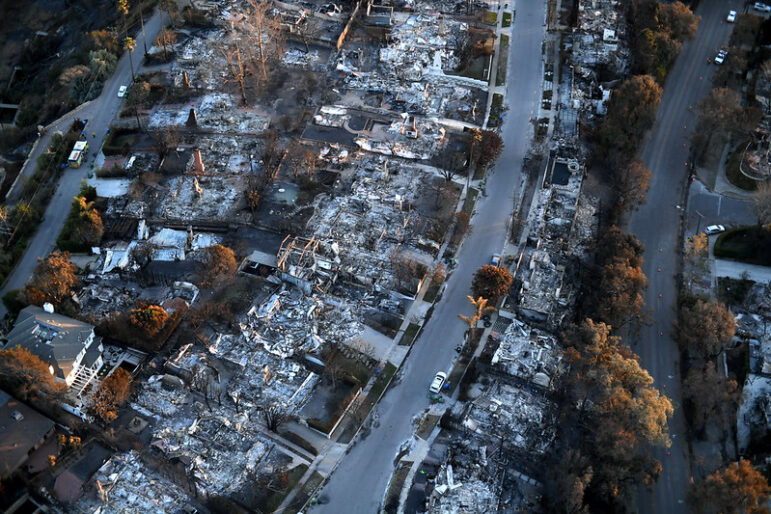
Neighborhoods devastated by the Palisades Fire near Pacific Palisades, California. Image: US Army National Guard, Sgt. 1st Class Jon Soucy via Flickr Creative Commons (CC BY 2.0).
Stone recommended that reporters keep masks and goggles on the entire time when out in active fire conditions. But she also admitted she doesn’t follow her own advice when conducting interviews.
“When I am trying to build empathy with people, especially people who have just lost everything, I want to be able to have them see my face,” she said. “I would take my mask off a little bit, and I know that I am risking that, and I don’t recommend that.”
The question of what kind of protective gear to use prompted plenty of discussion among the journalists. One touted the fire resistance of leather; another suggested taking all of your gear off outside your home, to keep the residues from fire away from the rest of your life.
Empathy Counts as You Approach Fire Lines
Reporters are well-advised to check in at incident command on an active wildland fire, as freelance journalist Jurgen Hess suggested.
But in January, as a dry landscape and hair-dryer winds collided in Southern California to create unpredictable conditions, officials closed roads and secured still-active areas — a new wrinkle for field reporting.
During those fires, getting stopped for checkpoint permissions from fire officials and law enforcement turned out to be an experience shared by multiple journalists.
“You’re all professional communicators,” said the LA Press Club’s Rose, who studies police-press interactions. “You’re going to want to do your research.”
In California, Rose said, that means knowing how to cite California Penal Code 409.7(a), which describes legal permissions for journalists to do their work.
Freelancers can face an additional burden of proving that they’re on assignment, added Hagerty. She has asked editors to write her letters, with their phone numbers included, so she can show them to law enforcement officials and sources.
Rose noted that while reporters may encounter both fire and police officials, each department manages checkpoints differently.
“The fire departments tend to appreciate press coming in, because they recognize it informs the public how dangerous the situation is and encourages evacuations,” he said. “Typically, the headaches come from law enforcement.”
And he pointed out a practical problem: that journalists approaching checkpoints may not encounter the same people day to day.
“Think about how much turnover there might be in your own newsroom,” he said. “The 21-year-old kid on the front line who’s just fresh out of the academy may not have a lot of experience. The supervisors may not have been around when the last big one was 20 years ago. The first thing to understand walking in is that most of the time, people don’t know what they’re doing.”
“A little bit of empathy can go a long way,” Rose added.
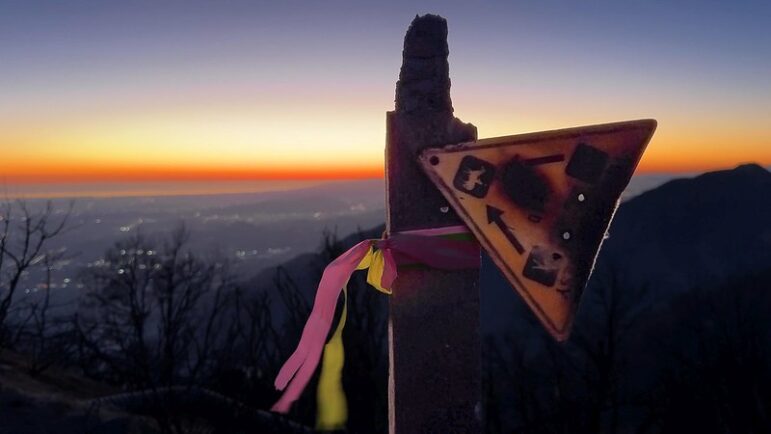
The edge of the Eaton Fire near Mount Wilson, January 14, 2025. Image: USDA Forest Service, Andrew Avitt
And Empathy Counts as You Approach Fire Survivors
When LAist’s Stone began to approach residents in Altadena after the fire, it was after she had also lost power and evacuated — an experience that reinforced her practice of showing consideration to survivors.
Stone said that the first thing she does when she approaches someone on scene, especially someone standing in front of their burnt home, is ask how they are doing and say she’s sorry for their loss. “Then I very respectfully introduce myself and say, very clear from the start, ‘You can absolutely tell me to go away right now, and I will respect that.’”
“It’s important to let survivors know they’re in charge,” she added. “I’m not here to just extract and leave.”
Hagerty stressed the importance of listening for when a survivor’s story may take a different direction than expected.
“The one other thing I try to do, especially nowadays when you might publish something and then it gets put on all sorts of different platforms, is just give them an idea of where the story is actually going to land,” she said.
Evolution of Fire News Reporting
Climate change is altering the tempo of wildfire news coverage, while misinformation is changing the reporting landscape, according to those on the front lines.
Montana-based wildfire journalist Kylie Mohr, whose work frequently appears in High Country News, reminded others that wildfire is a year-round story. “It doesn’t need to be confined to these individual disasters,” she said, especially because the reporting is getting more complicated.
“When possible, of course, connecting fires to climate change is really important, but also connecting it to all the other hosts of factors that are at play,” Mohr said. “If anyone tells you that it is just one thing, they’re probably wrong.”
Mohr and other journalists said they wrote stories combating misinformation early after the fires in January. But, she added, her sources sometimes said they were confused about why reporters are called to debunk statements or alleged storylines they called “nonissues,” like those regarding the water supply.
“In hindsight, I almost wonder if, by debunking it so thoroughly, we actually gave that theory and that misinformation so much oxygen,” Mohr said. “I don’t have the answer for it, but it did make me kind of think.”
Hagerty compared the misinformation after the LA fires to what happened after the Maui fires, when people were concerned that FEMA would grab their land. She believes it’s helpful to acknowledge the context around a concern like that, and “the kernel of truth, that can sort of spur that larger conspiracy or misinformation.”
Learning about the climate factors in a region’s wildfires, and the context for misinformation around those fires, can help reporters advocate for the best coverage, the webinar’s experts suggested. It’s one way of thinking of the problem from the inside out.
Preparing yourself for wildfire, from beginning to end, mentally and physically, protects the quality of your work.
“You are there to perform an act, it is to inform the public,” said Rose. “And that act is what we are trying to protect as a community.”
[Editor’s Note: This story was originally published by the SEJournal and is republished here with permission. Material for this story was drawn from an SEJ webinar moderated by the authors. Watch the video recording here and access resources and discussion notes here. And for more on this topic, check our Topics on the Beat: Wildfire page, with more than a dozen and a half SEJournal stories, plus wildfire headlines from EJToday.]
 Molly Peterson is a Los Angeles-based staff writer for PublicHealthWatch. Previously she worked in public media, at KQED, LAist, WWNO, NPR and, most recently, the California Newsroom, where she investigated the Clean Air Act and wildfires.
Molly Peterson is a Los Angeles-based staff writer for PublicHealthWatch. Previously she worked in public media, at KQED, LAist, WWNO, NPR and, most recently, the California Newsroom, where she investigated the Clean Air Act and wildfires.
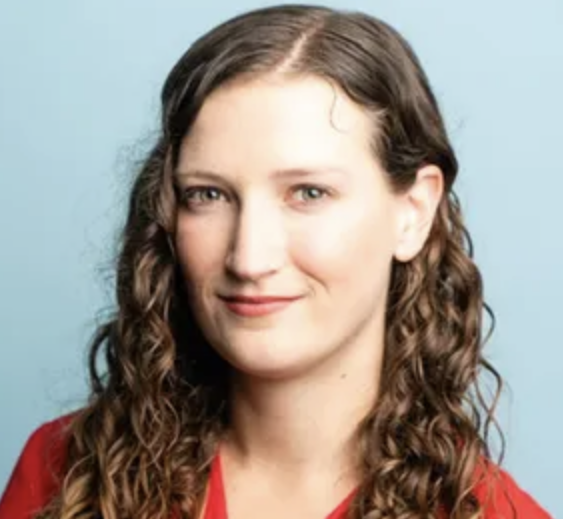 Caleigh Wells is a reporter for American Public Media’s Marketplace, where she frequently covers the intersection of climate and economics. She is a SEJ board member and previously she served as KCRW’s climate reporter and host of KCRW’s The Anti-Dread Climate Podcast. She reported with The California Newsroom on an investigation into the US Forest Service’s fire mitigation work that won a national Murrow award
Caleigh Wells is a reporter for American Public Media’s Marketplace, where she frequently covers the intersection of climate and economics. She is a SEJ board member and previously she served as KCRW’s climate reporter and host of KCRW’s The Anti-Dread Climate Podcast. She reported with The California Newsroom on an investigation into the US Forest Service’s fire mitigation work that won a national Murrow award


